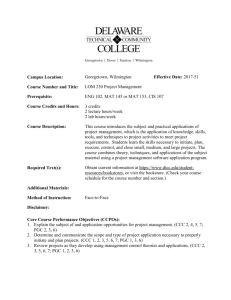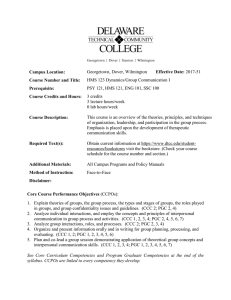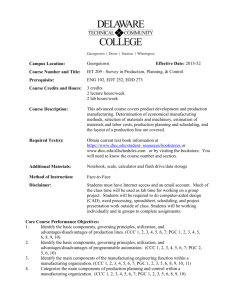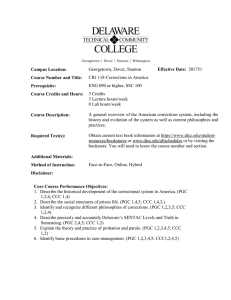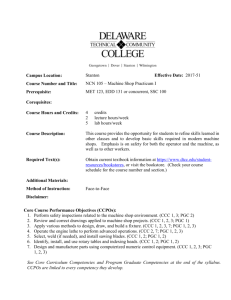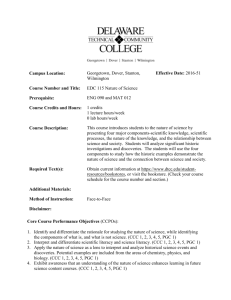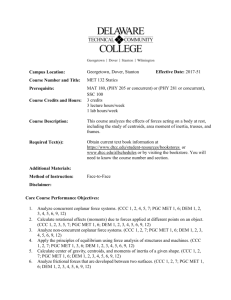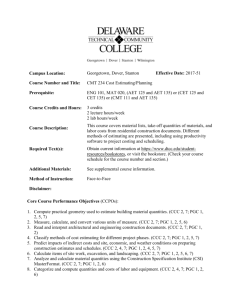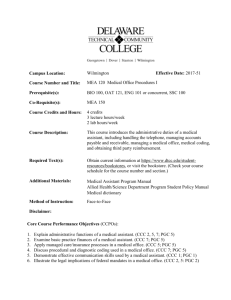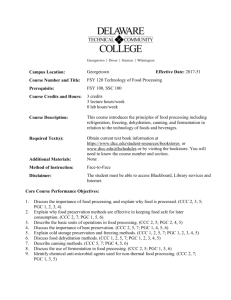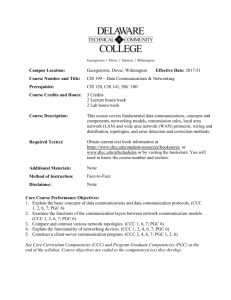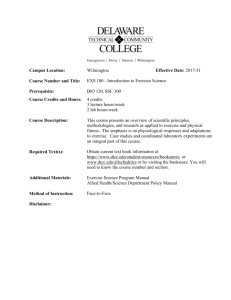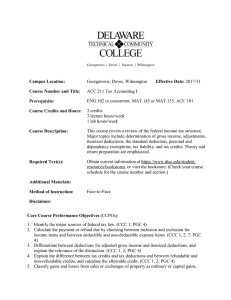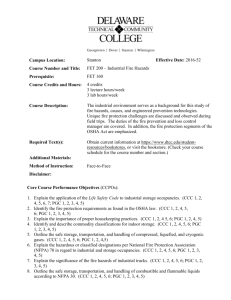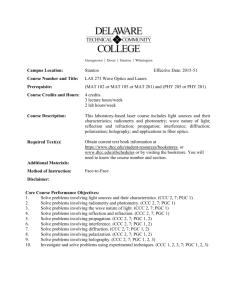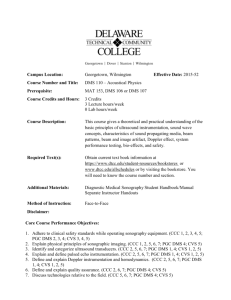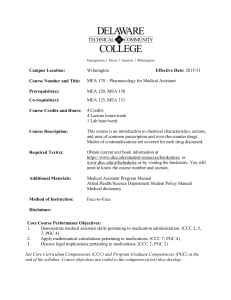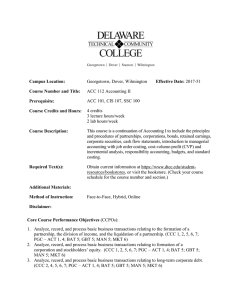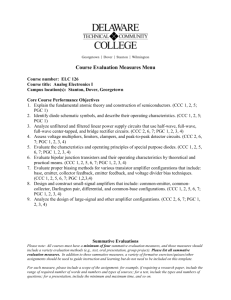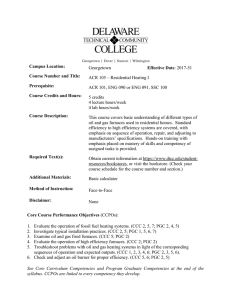CNE 215 201553 - E
advertisement
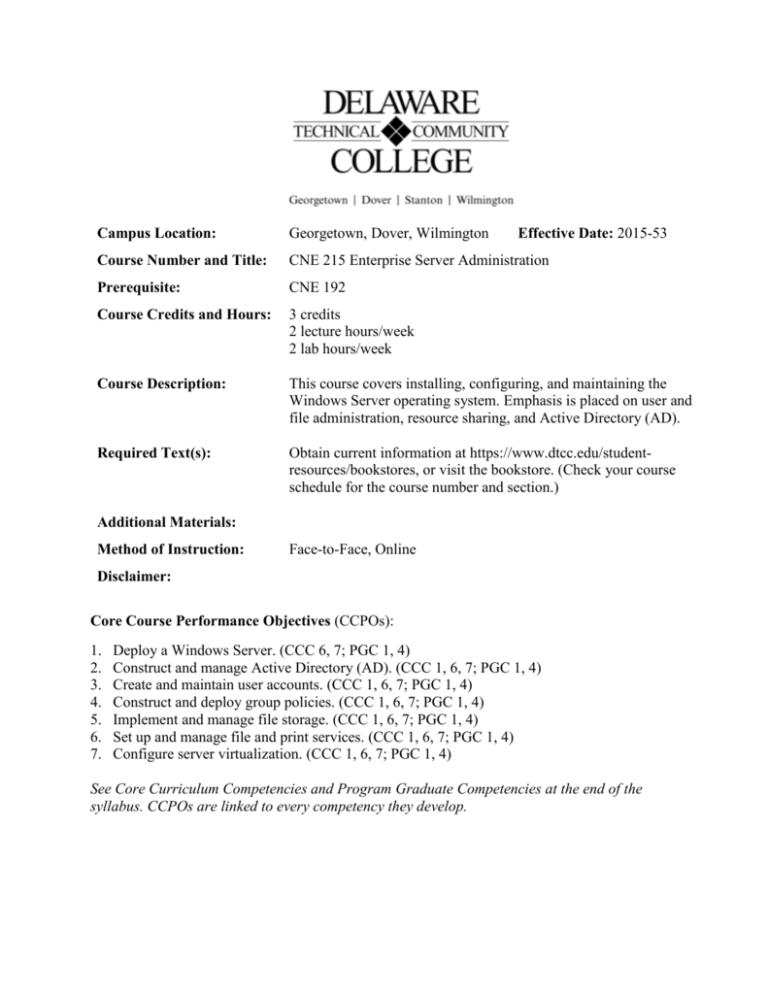
Campus Location: Georgetown, Dover, Wilmington Effective Date: 2015-53 Course Number and Title: CNE 215 Enterprise Server Administration Prerequisite: CNE 192 Course Credits and Hours: 3 credits 2 lecture hours/week 2 lab hours/week Course Description: This course covers installing, configuring, and maintaining the Windows Server operating system. Emphasis is placed on user and file administration, resource sharing, and Active Directory (AD). Required Text(s): Obtain current information at https://www.dtcc.edu/studentresources/bookstores, or visit the bookstore. (Check your course schedule for the course number and section.) Additional Materials: Method of Instruction: Face-to-Face, Online Disclaimer: Core Course Performance Objectives (CCPOs): 1. 2. 3. 4. 5. 6. 7. Deploy a Windows Server. (CCC 6, 7; PGC 1, 4) Construct and manage Active Directory (AD). (CCC 1, 6, 7; PGC 1, 4) Create and maintain user accounts. (CCC 1, 6, 7; PGC 1, 4) Construct and deploy group policies. (CCC 1, 6, 7; PGC 1, 4) Implement and manage file storage. (CCC 1, 6, 7; PGC 1, 4) Set up and manage file and print services. (CCC 1, 6, 7; PGC 1, 4) Configure server virtualization. (CCC 1, 6, 7; PGC 1, 4) See Core Curriculum Competencies and Program Graduate Competencies at the end of the syllabus. CCPOs are linked to every competency they develop. Measurable Performance Objectives (MPOs): Upon completion of this course, the student will: 1. Deploy a Windows Server. 1.1 Identify installation and management options to use while installing a Windows Server operating system. 1.2 Install a Windows Server operating system. 1.3 Configure and test a Windows Server operating system. 2. Construct and manage Active Directory (AD). 2.1 2.2 2.3 2.4 2.5 Explain the elements of AD. Design a plan for an AD deployment. Install AD services. Create directory structure. Manage AD. 3. Create and maintain user accounts. 3.1 3.2 3.3 3.4 Explain the purpose and function of user accounts. Develop a plan to create group accounts. Set up user authentication parameters. Construct and maintain group and user accounts. 4. Construct and deploy group policies. 4.1 Describe the purpose and function of group policies. 4.2 Formulate a plan to implement group policies. 4.3 Deploy group policies. 5. Implement and manage file storage. 5.1 Describe the different types of file storage. 5.2 Develop a file storage plan. 5.3 Install and maintain a file storage system. 6. Set up and manage file and print services. 6.1 Explain the function of file and print services. 6.2 Create a plan to manage file and print services. 6.3 Implement file and print services based on specific group policies. 7. Configure server virtualization. 7.1 Explain the concept of computer virtualization. 7.2 Install virtualization software. 7.3 Create a virtualized environment. Evaluation Criteria/Policies: Students must demonstrate proficiency on all CCPOs at a minimal 75 percent level to successfully complete the course. The grade will be determined using the DTCC grading system: 92 83 75 0 – – – – 100 91 82 74 = = = = A B C F Students should refer to the Student Handbook (https://www.dtcc.edu/academics/studenthandbook) for information on the Academic Standing Policy, the Academic Integrity Policy, Student Rights and Responsibilities, and other policies relevant to their academic progress. Core Curriculum Competencies (CCCs are the competencies every graduate will develop): 1. 2. 3. 4. 5. Communicate clearly and effectively both orally and in writing. Demonstrate effective problem solving and reasoning skills. Work effectively in groups of people from diverse backgrounds. Demonstrate ethical and professional understanding and conduct. Apply appropriate information literacy skills to locate, evaluate, and use information effectively. 6. Use computer technology appropriate to the field. 7. Use scientific and mathematical reasoning appropriate to the technology. Program Graduate Competencies (CCCs are the competencies every graduate will develop specific to his or her major): 1. Apply techniques, skills, and usage of the modern tools of a Computer Network Engineering Technician. 2. Apply analysis tools and problem-solving methods learned in the mathematics, computer, and electrical/electronic courses to troubleshoot network problems. 3. Diagnose and resolve network issues. 4. Install, configure, administer and troubleshoot network services for file access and storage, web-content hosting, network communications, network gateways and proxies, and security services on networking servers. 5. Design, install, configure, and operate Wide Area Networks (WAN) and Local Area Networks (LAN). 6. Explain the functions and the workings of common communications protocols, and how such protocols are developed by standards organizations.
